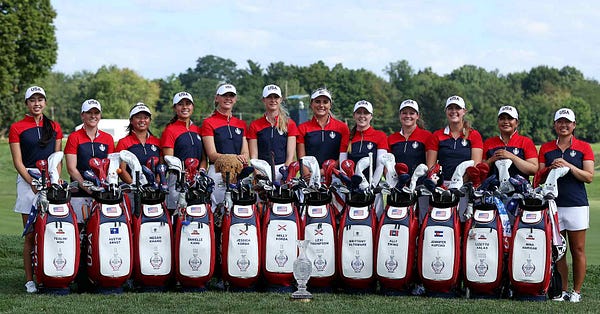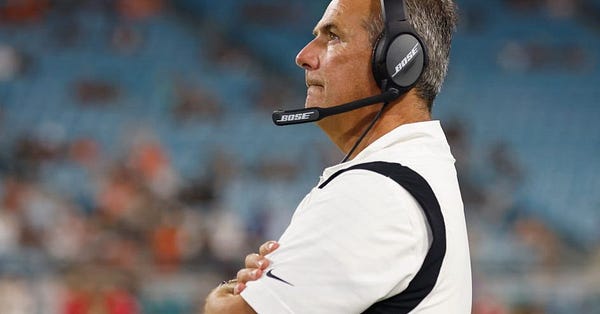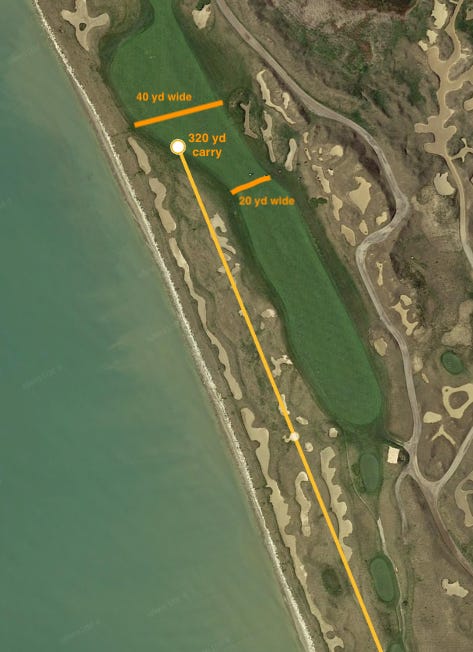Optionality, Bryson DeChambeau, and Team USA's Strategy for the Upcoming Ryder Cup
Optionality and Distance
Assume you have been admitted to more than one university, and your deadline for choosing where to attend is May 1st. Unless you have absolute certainty, it is probably wise to deliberate the decision until the deadline approaches. You might learn something about one of your universities that influences your decision. Maybe you will receive an unexpected scholarship. Conditions change! Importantly, there is no downside to waiting until close to the deadline. Why not take advantage of having multiple options?
Optionality is a powerful concept in sports as well (Have you noticed the prevalence of Run-Pass Options (RPOs) in football?). Optionality offers multiple paths; then a competitor can choose her optimal route.
The pursuit of distance is a hot topic in golf. Informed by statistical analysis, golfers are strengthening their bodies and chasing swing speed to reap the benefits of hitting the ball farther. But exactly how much is distance worth?
I’ve only seen this question answered with some flavor of the following methodology: compare expected values from two different distances to evaluate the benefits of increasing distance off the tee. In other words, the Tour expected value from 140 yards in the fairway is about 2.87 and the Tour expected value from 150 yards in the fairway is about 2.92. With a couple reasonable assumptions, one might conclude that gaining ten yards is worth 0.05 strokes (2.92-2.87) per swing, which equates to ~0.6 strokes per round since you do not hit driver on every single hole.
I want to suggest that this methodology understates the value of distance. Why? Optionality.
When a golfer increases her length, options become available that were not plausible options before. For instance, the difference between barely flying a fairway bunker versus landing in the fairway bunker is often worth more than a half of a stroke. The value of that scenario is not represented in the above methodology, right?
If I wanted to design a golf hole to cater to the strengths of the longest hitters, I’d place a large body of water at a length at which only the longest players could clear the water. Any player incapable of clearing the water must lay up, while the longest players will carry the water. Well actually, maybe some of the long hitters will elect to lay up for some reason, but they have an additional option that is unavailable to shorter hitters. The additional option is valuable.
When media discuss the benefit of adding length to one’s game, I’d like to see the concept of optionality enter the conversation.
Bryson DeChambeau
No professional golfer has embraced the value of distance more than Bryson DeChambeau. From the end of 2019 into mid-2020, DeChambeau gained 40+ pounds and picked up significant club head speed. He decided to become the longest player on Tour at the expense of accuracy, and it has been a successful experiment to date.
However, when a player hits the ball 350 yards and a little bit off target, the shot will travel more wayward than if he had hit the ball 300 yards and the same degree off target. In theory, Bryson DeChambeau’s experiment should result in finding more penalty hazards.
The data confirm the theory. Since May 2020, on holes with a hazard where Bryson hits driver, his performance is almost 0.1 strokes per hole worse than on holes without a hazard.
So if my goal is to create the perfect golf course for Bryson DeChambeau, I am not including hazards that run alongside holes. I also want to design the holes in such a way that driver is the obvious club selection. I do not want the fairway to narrow at the 330 yard mark or wherever Bryson’s drive will end up. DeChambeau is able to realize his distance advantage when hitting driver; his distance advantage is mitigated when the shape of the hole calls for a 3-wood or a long iron off the tee.
The golf course I am creating sounds a lot like Winged Foot, or Torrey Pines, or more recently, Caves Valley.
Circling back to the concept of optionality, remember how I suggested that the ideal golf hole for a long hitter would have a body of water that only he could clear? Check out Hole 11 at Caves Valley:
The hole presents a daunting carry that few players can attempt. Yet, Bryson can walk up to the tee box each day and evaluate whether or not attempting the carry is optimal. He does not have to attempt the shot, but it is an option to him… Bryson is one of two players in the field who birdied the hole all four days.
I had tweeted the following before Bryson’s first round at Caves Valley:

Ultimately, DeChambeau tied for first and lost in a playoff. Going forward, you should expect him to outperform at lengthy venues that call for hitting driver often, especially if hazards are absent.
Team USA’s Strategy at the Upcoming Ryder Cup
The Ryder Cup is just a few weeks away. For those who are unfamiliar with the event, the Ryder Cup is an exciting team competition with a unique format featuring the best male golfers from the United States versus the best male golfers from Europe. I’ve written about it before here, which I recommend reading for additional context.
This year’s Ryder Cup is hosted at Whistling Straits Golf Course, a course that will reward length off the tee more than the typical PGA Tour course. Fortunately for the American team, Team USA will have more long hitters than Team Europe has.
I am going to propose a strategy for Team USA, and to agree with the philosophy, you have to accept that not all holes are equal and not all shots are equal. If Dustin Johnson could choose a hole to play against me for $100M dollars, he should not select a 210-yard Par 3 with a large green like Hole 7 at Whistling Straits. I can par that hole at reasonably high frequency, and Dustin will not make birdie very often. In the 2015 PGA Championship at Whistling Straits, almost 70% of the field made par on Hole 7 and just 11% of the field made birdie. In determining optimal strategy for Team USA, we should not worry too much about whose skill set aligns with Hole 7. The range of outcomes is narrow. By contrast, the Par 5 Hole 11 yields nearly as many birdies at it yields pars. We should pay more attention to Hole 11 than Hole 7.
Additionally, not all holes are equally correlated with players’ length. Par 5s and drivable Par 4s are generally most correlated with length. At Whistling Straits, there are four Par 5s (#2, #5, #11, and #16). And there are two Par 4s that can be set up as drivable (#6 and #10). The holes least correlated with length are odd-numbered.
Finally, you must accept that mixing up skill sets is preferred to pairing similar players together. Players have distinct strengths and weaknesses; therefore, players’ expected outcomes vary by hole profile. In simpler terms, we expect long hitters like Bryson DeChambeau to fare better on Par 5s than on a mid-length Par 4 with an out of bounds hazard. You want to pair Bryson with someone who will excel on different holes than the holes Bryson will excel on. Within the format, only one score counts per team. If two partners birdie the same hole, one player may as well have made a quintuple bogey. Spread out the outperformance.
So with those factors in mind, here is what I would do as captain of Team USA.
In both fourballs and foursomes, I would ensure that a long hitter is hitting the tee shot on every even-numbered hole. He will get to hit the tee shot on the holes where length is most important: two Par 5s and two drivable Par 4s. Likely, this will result in pairing the long hitters with shorter hitters, who will bring outperformance on different holes. There is no scenario in which I would pair two shorter hitters together at Whistling Straits.
The proposed strategy delivers subtle benefits in the alternate shot format. Generally speaking, a shorter hitter will have a solid short game; otherwise, a short hitter with bad short game would probably not be of the caliber to make the roster. So when the longer player tees off on the two drivable Par 4s in alternate shot, the player with strong short game will hit the second shot from on or around the green. Perfect, that shot is right in his wheelhouse!
Oh, also I would manipulate Hole 4, an even-numbered hole, to make length even more important than it already is on that hole.
Here’s Hole 4:
To deter players from bombing away with driver, many holes on Tour get narrower at the point where long drives will end up. From the back tees on Hole 4, 300 yard drives must thread a very tight 20-yard gap to find the fairway, unless a player can carry his drive 320+ yards, which is a long carry.
I would not use the back tee box. Since Team USA has longer hitters than Team Europe has, and since we are deploying our long hitters on the even-numbered holes, I would set the tee box so that my shortest hitting player teeing off on Hole 4 can just reach the 40-yard-wide section of the fairway that I’ve highlighted above.
Effectively, I’m inverting the traditional risk-reward math. I want to widen the fairway for the longest hitters (Team USA) while shrinking the fairway for the shortest hitters (Team Europe). Configuring the hole this way creates a massive advantage.
Team USA has the more talented roster and the golf course favors Team USA. I’m eager to see how Captain Stricker tries to gain an advantage through player pairings and setting the course up.
Solheim Cup
In a previous newsletter, I had groaned about the role of behavioral analysis in pairing players together for the Ryder Cup. I do not want to argue that team chemistry is irrelevant. I do want to argue that players’ skill sets are a far more important contributor towards success than personalities and “intangibles.”
I had concluded my argument with the joke that maybe pairings should be entirely based on players’ Zodiac signs. Well the Solheim Cup, the women’s equivalent of the Ryder Cup, took place this past weekend.
Here’s how the captain of Team USA decided pairings:


Liberal use of the word “strategically”! Captain Hurst noted that the behavioral assessment constituted about 75% of the rationale for the pairings.
Anyway, Team USA entered the Solheim Cup as strong favorites and Team Europe hoisted the trophy at the end of the weekend. I’d like to see a more intelligent approach to pairings next time around…
Contact/Feedback
Twitter: @JosephLaMagna
Email: Joseph.LaMagnaGolf@gmail.com
Other Content from this Past Week
I went on The Fried Egg Golf Podcast to discuss Team Match Play strategy. Give it a listen!
Rookie kicker Quinn Nordin made the New England Patriots team last week. Check out an interview of his from a month ago:

Reminds me of this!


Don’t say it out loud, Urban! Normally he gets in trouble for remaining silent when he should say something


This clip resurfaced yesterday and I cannot stop laughing at it:



